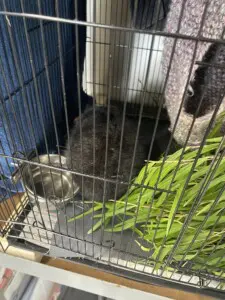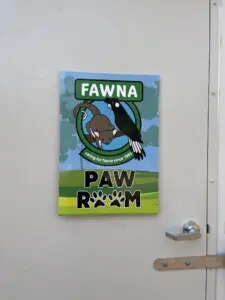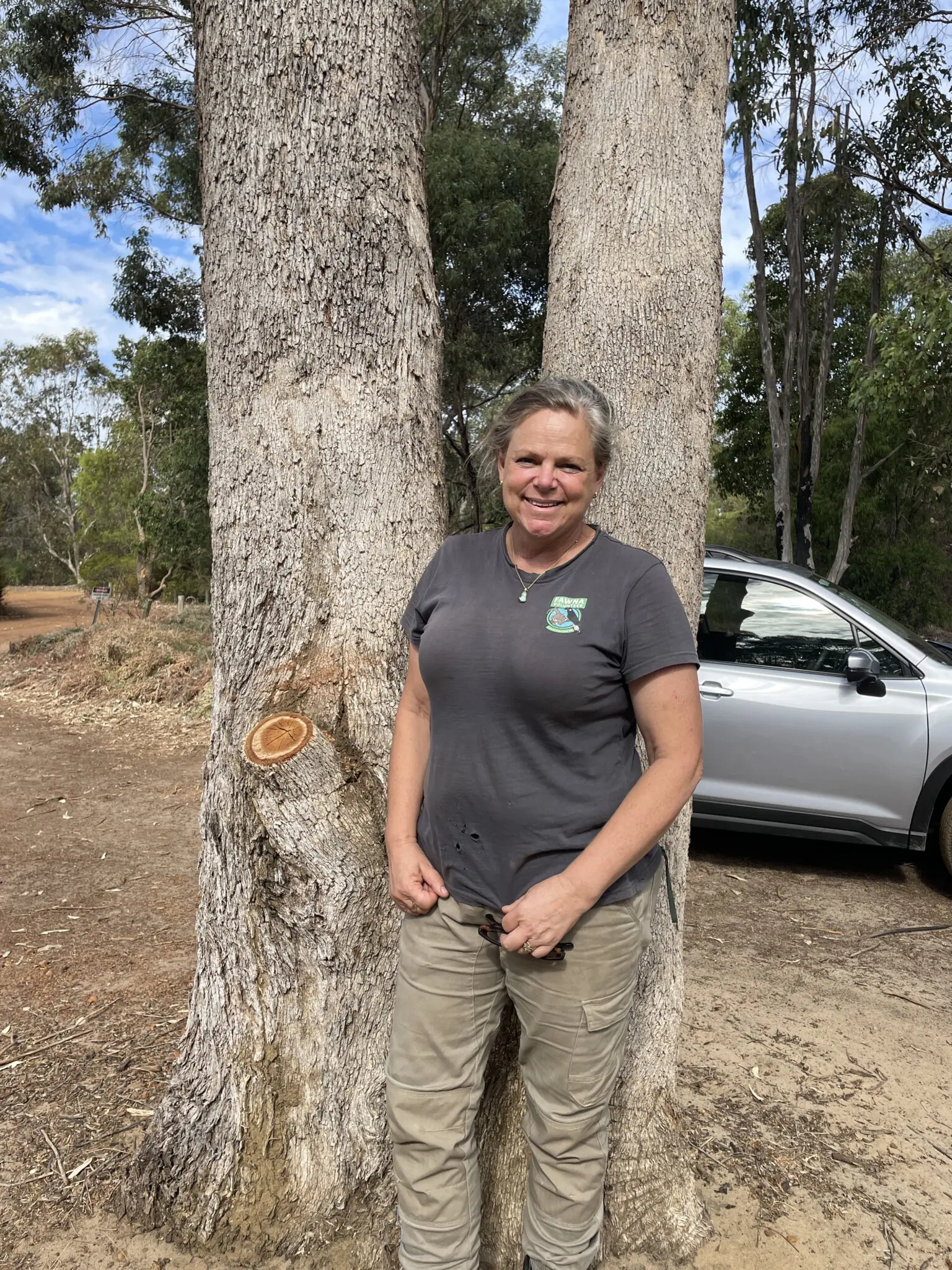On February 28, we visited Capel, south west Western Australia, to interview Community Champion Award winner Suzi Strapp.
Fortuitously, we met Suzi on 40th Anniversary of the establishment of FAWNA.
 Tell us a bit about yourself.
Tell us a bit about yourself.
I’m a retired audiologist with a 20-year background in the health profession.
Despite my successful career, I felt confined indoors and sought solace in my childhood love for wildlife. Growing up, I assisted my father in outdoor activities like duck and kangaroo shoots, ensuring humane treatment of surviving animals. Inspired by my idols Harry Butler, David Attenborough, and Jane Goodall, I transitioned into caring for possums.
Recognising the lack of structure in wildlife organisations, I aimed to bring scientific rigour to the field.
Over time, volunteer demographics changed, and urban constraints made traditional wildlife care less feasible. This led to the idea of establishing a dedicated centre, eventually locating it on a former mine site.
The transition from audiologist to wildlife enthusiast reflects my journey seeking peace and a connection to the outdoors.
What did it mean to you to win the CRC TiME Community Champion Award?
It was fortuitous timing, as I really needed a lift. It also doubled as a break to evaluate the trajectory of our wildlife care efforts right after the spring influx of baby animals and anticipating a challenging summer. Though I missed the first cases of burnt possums that came in that week, it allowed my team to step up and make decisions in my absence.
The highlight was showcasing the potential of repurposing a mine site, particularly this remarkable one focused on wetlands and environmental education.
The project originated from a thoughtful response to the 2008 global financial crisis, and though progress had slowed, winning the CRC TiME Award brought FAWNA front and centre, emphasising our commitment to community collaboration for long-term positive outcomes.
I think you’ve definitely answered this, but I’ll ask it again, what inspired you to join FAWNA?

Keeping our doors open!
By leveraging visual storytelling and highlighting achievements, such as the CRC TiME Community Champion Award, we’re gaining increased recognition in the community.
It’s crucial to communicate the importance of wildlife conservation to a broader audience, and platforms like CRC TiME offer a substantial reach. Our primary focus is on conveying this message to individuals who can contribute to our goal of establishing a regional wildlife hospital in Western Australia.
Growing up in the 70s, my fascination with wildlife was fuelled by TV shows like those featuring Harry Butler and the Leyland Brothers, showcasing Australia’s beautiful wildlife.
Despite this, wildlife conservation efforts in Australia have been insufficient, lacking funding and legislation for wildlife welfare.
Recognising the loss of nearly 70% of Western Australia’s habitat to various activities, I felt a personal responsibility to care for wildlife. Exhausted after a 20-year career in audiology, I sought a deeper connection with nature and local wildlife.
This led to the redefinition and transformation of FAWNA, turning it into the wildlife welfare group it is today.
How is FAWNA working to repurpose a former mine site?
Initially, we sought a location for a Possum Finishing School as part of a grant-funded research project with The University of Western Australia, the Department of Biodiversity, Conservation and Attractions (DBCA), and the Southwest Catchment Council. The aim was to hand-raise critically endangered western ringtail possums, release them to the wild, and monitor their survival, challenging the practice of unregulated releases.

The Possum Finishing School, designed to teach possums to be wild, required a sizable space to separate them from domestic influences. Simultaneously, we dreamed of a wildlife hospital, but the financial challenges were daunting, with estimated annual costs exceeding $1 million.
To overcome this, we reversed our approach, seeking an income generator that could fund the hospital while supporting ecosystem rehabilitation and education.
Knocking on Illuka’s door, we discovered their recent plans for the site and proposed an open-plan biodiversity park, avoiding fences and allowing local species to thrive. The idea resonated, and our synchronous collaboration is turning a partially rehabilitated mine site into a public space that contributes directly to animal welfare, funding a wildlife hospital and ongoing research.
The potential of this transformative project is truly remarkable.
What has it been like working with Illuka?
It’s actually been quite amazing because they’re really positive and can do. Being an audiologist, I worked with a lot of mining companies because I was involved in occupational health and safety.
I’d say I bring ideas to the table, while Rob Brown, Closure Planning Manager at Iluka, and his colleagues navigate the legal and company constraints to turn them into achievable goals. Being a small, volunteer-run nonprofit, we must ensure we are a positive asset to the company, following rules and regulations.
Rob’s invaluable guidance ensures our safety and compliance on the mine site, providing advice on equipment, training, and clothing for our volunteers.
The local community, including many Iluka and former RGC employees, are enthusiastic about the project, having witnessed its positive impact in the 2000s. Some have even visited, expressing their connection to the site and its potential.

What is the greatest challenge of running FAWNA?
Despite our limited resources and lack of ongoing government funding, Australians showcase remarkable innovation.
Even within our recently established ‘Paw Room’, we’ve implemented numerous creative solutions.
FAWNA operates on a minimal budget, relying on grants and community support, constantly shaking the can for funds. However, ongoing costs, such as employment, electricity, and insurance, remain challenging. The volunteer base, already strained after COVID, has seen a decline, with people taking long-awaited holidays or juggling multiple jobs. This leaves us with dedicated but fatigued volunteers, especially during the demanding summer period.
What is FAWNA’s greatest achievement to date?
While we make the best use of our current resources and this fortunate location, spreading awareness is key to making a significant impact on wildlife welfare, not just locally but also across the state. Our aim is to create a model that can be replicated in other regions facing similar challenges, as witnessed during a recent visit to the struggling Great Southern area.
You briefly spoke about them in your greatest achievement, but what are the future goals for Fauna?
Our primary objective is to establish a wildlife hospital, a crucial resource currently unavailable to us.
While our immediate goal may involve a mobile wildlife hospital similar to Byron Bay Wildlife Hospital, the real challenge lies in securing funds for veterinary care and ongoing hospital costs.
To address this, we aim to set up the larger Kaatijinup Biodiversity Park project, a project we’re consistently working towards. Encouraging community support is vital in conveying the necessity of these initiatives for wildlife welfare, even if government departments may have differing perspectives.
Despite varying approaches, the community’s unified voice is essential in advocating for these vital resources.
Two more questions. What would you recommend to others working to repurpose former mine sites?
I encourage individuals and community groups to engage with mine managers and explore possibilities for collaboration. It’s essential to reach out to organisations like CRC TiME for examples of successful partnerships, as abandoned mine sites could serve as valuable spaces for groups in need.
Serendipitously, our alignment with the mine’s goals led to successful research outcomes, showcasing the Australian spirit of giving things a try.
This model could be applied to various endangered species with the support of educational institutions, universities, DBCA, and Natural Resource Management groups in our region.
Last question, how can people best help FAWNA?
To support our cause, individuals can engage by liking and sharing our page, urging ministers to address the absence of a regional wildlife hospital in Western Australia, and utilizing available templates on Facebook for advocacy.
Additionally, endorsing the Wildlife Matter program, advocating for a national wildlife welfare bill, would ensure consistent funding for wildlife hospitals and rehabilitation groups nationwide.
As our initiatives, like the Flight Academy, progress, we welcome organisations to sponsor aviaries and enclosures, enhancing our activities. Active involvement, both in sponsorship and volunteering, contributes to our growth and raises awareness about our ongoing efforts.
Find out more on the FAWNA website.
Interview by Ben Hamilton, Communications Officer, CRC TiME.

